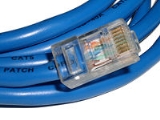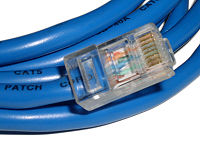
Patch cable
Encyclopedia

Microphone
A microphone is an acoustic-to-electric transducer or sensor that converts sound into an electrical signal. In 1877, Emile Berliner invented the first microphone used as a telephone voice transmitter...
cables, headphone extension cables, XLR connector
XLR connector
The XLR connector is a style of electrical connector, primarily found on professional audio, video, and stage lighting equipment. The connectors are circular in design and have between 3 and 7 pins...
, Tiny Telephone (TT) connector, RCA connector
RCA connector
An RCA connector, sometimes called a phono connector or cinch connector, is a type of electrical connector commonly used to carry audio and video signals...
and ¼" TRS connector
TRS connector
A TRS connector is a common family of connector typically used for analog signals including audio. It is cylindrical in shape, typically with three contacts, although sometimes with two or four . It is also called an audio jack, phone jack, phone plug, and jack plug...
cables (as well as modular
Modular connector
Modular connector is the name given to a family of electrical connectors originally used in telephone wiring and now used for many other purposes. Many applications that originally used a bulkier, more expensive connector have now migrated to modular connectors...
Ethernet
Ethernet
Ethernet is a family of computer networking technologies for local area networks commercially introduced in 1980. Standardized in IEEE 802.3, Ethernet has largely replaced competing wired LAN technologies....
cables), and thicker, hose-like cords (snake cable) used to carry video
Video
Video is the technology of electronically capturing, recording, processing, storing, transmitting, and reconstructing a sequence of still images representing scenes in motion.- History :...
or amplified signals. However, patch cords typically refer only to short cords used with patch panel
Patch panel
A patch panel or patch bay is a panel, typically rackmounted, that houses cable connections. One typically shorter patch cable will plug into the front side, whereas the back holds the connection of a much longer and more permanent cable...
s.
Patch cords can be as short as 3 inches (ca. 8 cm), to connect stacked components or route signals through a patch bay, or as long as twenty feet (ca. 6 m) or more in length for snake cables. As length increases, the cables are usually thicker and/or made with more shielding, to prevent signal loss (attenuation
Attenuation
In physics, attenuation is the gradual loss in intensity of any kind of flux through a medium. For instance, sunlight is attenuated by dark glasses, X-rays are attenuated by lead, and light and sound are attenuated by water.In electrical engineering and telecommunications, attenuation affects the...
) and the introduction of unwanted radio frequencies and hum (electromagnetic interference
Electromagnetic interference
Electromagnetic interference is disturbance that affects an electrical circuit due to either electromagnetic induction or electromagnetic radiation emitted from an external source. The disturbance may interrupt, obstruct, or otherwise degrade or limit the effective performance of the circuit...
).
Patch cords are often made of coaxial cable
Coaxial cable
Coaxial cable, or coax, has an inner conductor surrounded by a flexible, tubular insulating layer, surrounded by a tubular conducting shield. The term coaxial comes from the inner conductor and the outer shield sharing the same geometric axis...
s, with the signal carried through a shielded core, and the electrical ground or earthed return connection carried through a wire mesh surrounding the core. Each end of the cable is attached to a connector so that the cord may be plugged in. Connector types may vary widely, particularly with adapting cables.
Patch cords may be:
- single-conductorElectrical conductorIn physics and electrical engineering, a conductor is a material which contains movable electric charges. In metallic conductors such as copper or aluminum, the movable charged particles are electrons...
wires using, for example, banana connectorBanana connectorA banana connector is a single-wire electrical connector used for joining wires to equipment. The term 4 mm connector is also used, especially in Europe, although not all banana connectors will mate with 4mm parts...
s - coaxial cableCoaxial cableCoaxial cable, or coax, has an inner conductor surrounded by a flexible, tubular insulating layer, surrounded by a tubular conducting shield. The term coaxial comes from the inner conductor and the outer shield sharing the same geometric axis...
s using, for example, BNC connectorBNC connectorThe BNC connector ' is a common type of RF connector used for coaxial cable. It is used with radio, television, and other radio-frequency electronic equipment, test instruments, video signals, and was once a popular computer network connector. BNC connectors are made to match the characteristic...
s - Twisted pairTwisted pairTwisted pair cabling is a type of wiring in which two conductors are twisted together for the purposes of canceling out electromagnetic interference from external sources; for instance, electromagnetic radiation from unshielded twisted pair cables, and crosstalk between neighboring pairs...
Cat5, Cat5e, or Cat6 cables using 8P8C (RJ-45) modular connectorModular connectorModular connector is the name given to a family of electrical connectors originally used in telephone wiring and now used for many other purposes. Many applications that originally used a bulkier, more expensive connector have now migrated to modular connectors...
s with T568A or T568B wiring - Optical fiberOptical fiberAn optical fiber is a flexible, transparent fiber made of a pure glass not much wider than a human hair. It functions as a waveguide, or "light pipe", to transmit light between the two ends of the fiber. The field of applied science and engineering concerned with the design and application of...
cables
A patch cord is always fitted with connectors at both ends. A pigtail is similar to a patch cord and is the informal name given to a cable fitted with a connector at one end and bare wires (or bare fiber) at the other. The non-connectorized end ('the pigtail') is intended to be permanently attached to a component or terminal.
Music and sound recording
A variety of cables are used to carry electrical signals in sound recording studios and with electronic or electrical musical instruments. Microphones are typically connected to mixing boards or PA systems with XLR microphoneMicrophone
A microphone is an acoustic-to-electric transducer or sensor that converts sound into an electrical signal. In 1877, Emile Berliner invented the first microphone used as a telephone voice transmitter...
cables which use three-pin XLR connector
XLR connector
The XLR connector is a style of electrical connector, primarily found on professional audio, video, and stage lighting equipment. The connectors are circular in design and have between 3 and 7 pins...
s. A huge range of electric or electronic instruments use 1/4 inch mono patch cords to connect the instrument to the amplifier, such as the electric guitar
Electric guitar
An electric guitar is a guitar that uses the principle of direct electromagnetic induction to convert vibrations of its metal strings into electric audio signals. The signal generated by an electric guitar is too weak to drive a loudspeaker, so it is amplified before sending it to a loudspeaker...
, electric bass
Electric Bass
Electric bass can mean:*Electric upright bass, the electric version of a double bass*Electric bass guitar*Bass synthesizer*Big Mouth Billy Bass, a battery-powered singing fish...
, synthesizer
Synthesizer
A synthesizer is an electronic instrument capable of producing sounds by generating electrical signals of different frequencies. These electrical signals are played through a loudspeaker or set of headphones...
, electric piano
Electric piano
An electric piano is an electric musical instrument.Electric pianos produce sounds mechanically and the sounds are turned into electrical signals by pickups. Unlike a synthesizer, the electric piano is not an electronic instrument, but electro-mechanical. The earliest electric pianos were invented...
, or electronic drum machine
Drum machine
A drum machine is an electronic musical instrument designed to imitate the sound of drums or other percussion instruments. They are used in a variety of musical genres, not just purely electronic music...
. Musicians playing electric or electronic instruments often use longer cables (from 10 to 20 feet) between their instrument and their amplifier, and then use shorter patch cords (from a few inches to one or two feet long) to connect chains of effects devices, "stomp box
Effects unit
Effects units are electronic devices that alter how a musical instrument or other audio source sounds. Some effects subtly "color" a sound, while others transform it dramatically. Effects are used during live performances or in the studio, typically with electric guitar, keyboard and bass...
" pedals, or other signal processors.
DJs using record players connect their turntables to mixers or PA systems with stereo RCA connector
RCA connector
An RCA connector, sometimes called a phono connector or cinch connector, is a type of electrical connector commonly used to carry audio and video signals...
s. DJs sometimes have to use equipment with multiple cable types, which can create connection difficulties; for example, the DJ's record players and DJ mixers all use RCA connectors, but if they use a drum machine or a bass synthesizer, it may have a 1/4 inch mono connector. To resolve this problem, DJs can either use adapters or special cables (e.g., RCA to 1/4 inch mono). Heavier-gauge cables are used for carrying amplified signals from amplifier
Amplifier
Generally, an amplifier or simply amp, is a device for increasing the power of a signal.In popular use, the term usually describes an electronic amplifier, in which the input "signal" is usually a voltage or a current. In audio applications, amplifiers drive the loudspeakers used in PA systems to...
s to speakers (both in a PA system and with instrument amplifier
Instrument amplifier
An instrument amplifier is an electronic amplifier that converts the often barely audible or purely electronic signal from musical instruments such as an electric guitar, an electric bass, or an electric keyboard into an electronic signal capable of driving a loudspeaker that can be heard by the...
s). ¼" TRS connector
TRS connector
A TRS connector is a common family of connector typically used for analog signals including audio. It is cylindrical in shape, typically with three contacts, although sometimes with two or four . It is also called an audio jack, phone jack, phone plug, and jack plug...
cables can carry stereo signals, so they are used for stereo headphones and for some patching purposes (e.g., inserting an effect into an insert connection in a mixer).
Music venues, concert halls, and recording studios also use a thicker, hose-like cord called a snake cable (or a "snake"), which consists of a bundle of many individual cables with patch bays at either end so that audio gear can be connected. The patch bay is a flat panel of audio connectors where XLR cables (often both "male" and "female") and 1/4 inch jacks can be plugged in. The "snake" cable makes setup more convenient, because if a sound engineer did not have a "snake", she or he would have to run 20 or 30 individual microphone and instrument cables from the stage to the mixing booth. The cables could get tangled or mixed up, and it would be hard to know, when faced with 20 connectors at the end of the cable run, which cable was associated with which microphone or instrument. The patch bay is numbered, so that the engineer can note which microphone or instrument is plugged into each numbered connection.

